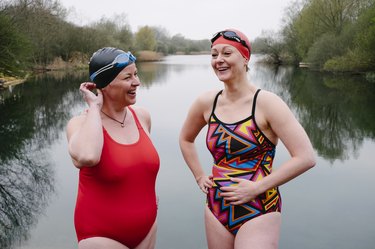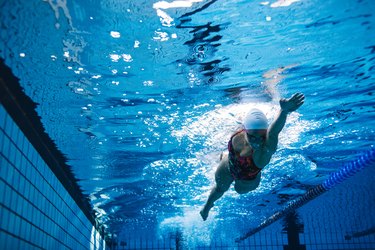
A hysterectomy is the removal of the uterus. Although many hysterectomies can be laparoscopic, which is less invasive than open surgery, the procedure still requires a lot of recovery, which means exercise, including swimming, may be off the table for awhile.
It's important to consider your overall healing timeline and goals when thinking about returning to any activity, but especially swimming, after having a hysterectomy. The chemicals in a pool, core and leg movement, and potential bacteria of open water all require extra thought before (literally) diving into swimming after a hysterectomy.
Video of the Day
Video of the Day
What Is a Hysterectomy?
A hysterectomy is an operation to remove the uterus. The uterus is a "hollow, pear-shaped organ in a woman's pelvis," where a fetus can develop, according to the National Cancer Institute. There are two types of hysterectomy surgeries, according to the Mayo Clinic:
- abdominal hysterectomy, where the uterus is removed via the lower abdomen
- vaginal hysterectomy, where the uterus is removed via the vaginal canal
A patient may choose either type of hysterectomy for a variety of reasons, according to Abby Bales, DPT, a pelvic floor physical therapist based in New York City.
"A patient may opt for an open abdominal surgery if they are doing an exploratory search of the abdomen for other medical issues such as uterine fibroids," Bales says. "Others may opt for a vaginal surgery as it will not leave an obvious scar on the abdomen — there are many reasons for choosing either option."
Reasons for a Hysterectomy
There are numerous reasons someone might choose to get a hysterectomy.
"The most common reasons for a hysterectomy that my clinic sees are uterine cancer, uterine fibroids, endometriosis and uterine prolapse," Bales says. "Others may opt to have their uterus removed due to family history and a higher risk of certain types of cancer."
Uterine fibroids are noncancerous growths in the uterus that can become heavy and painful in some cases, according to the Mayo Clinic.
Endometriosis is when uterine cells are found outside of the uterus. These cells continue to expand and bleed, but unlike uterine cells whose blood can leave the body via menstruation, the trapped cells' blood remains in the body, causing bloating, pain and complications.
Uterine prolapse is when the uterus "sinks" within the pelvic area and can limit movement and cause discomfort.
"Uterine prolapse is when the uterus prolapses down toward the vagina from its normally high position within the pelvis," Bales explains. "This can be uncomfortable and also restrict movement."
Hysterectomy Recovery
Patients recovering from a hysterectomy are going to be doing minimal (if any) activity for the first four weeks post-operation.
Hysterectomy recovery time can vary person-to-person, but there are some general guidelines that all should consider.
"Rehab from a hysterectomy is similar to postpartum C-section rehab in that you are waiting for the tissue to heal before you can increase any tensile forces onto that tissue," Bales says. "This means that for about the first four weeks after your operation, you are going to be doing light walking, activities of daily living such as getting up from the toilet, and easy housework such as putting away the dishes or cleaning the counters."
It is not advised for patients to use tampons, have sexual intercourse or submerge themselves in any water, including a bath, during these first four weeks.
Leah Roberts, MD, is a board-certified emergency medicine physician in New Jersey and advises patients to remember that there is necessary healing going on both externally and internally post-hysterectomy.
"I advise no submerging in water — bath, pool, open water — until stitches are removed. This way, your surgeon can accurately assess how the wound is healing," Dr. Roberts says. "The length of time to wait for swimming after a hysterectomy is dependent on a surgeon's recommendations, but is typically four to six weeks. Although the skin incision may appear healed after two to three weeks, the various types of tissues, both external and internal, that were involved in the surgery are still healing."
Roberts goes on to explain that the skin is an important barrier to toxins and bacteria during recovery.
"Submerging a wound in water for periods of time delays wound healing and increases the chances of infection. The epidermis is an important barrier to protect the body from bacteria and other toxins entering the body," Dr. Roberts says. "Wound healing goes through several stages any time there is injury to the skin: bleeding control, inflammatory factors, cell regeneration and cell remodeling. This entire process can take six weeks."
Swimming After a Hysterectomy
Swimming can be a complex activity to resume post-op, as water often involves chemicals and/or bacteria that can hinder or even damage hysterectomy recovery.
Dr. Roberts explains that the first three days post-op are critical for setting yourself up for success in healing well.
"For at least 72 hours post-surgery, the wound should be kept dry and dressings should be changed with clean hands," Dr. Roberts says. "Ask your surgeon if you should be using an antibiotic ointment on the wound. Continue to monitor the wound for any signs of infection and keep the wound clean and dry. If clothes are irritating the wound, apply a nonadhesive dressing to the area."
Bales adds that beyond the 72-hour window, it's important to be certain their body is ready to return to swimming.
"The first step in even thinking about returning to swimming post-op is that your stitches have to be healed and you should not have any blood or discharge coming from any part of the body," Bales says. "This could take a month or more. Every person is different."
Remain in close contact with your surgeon and care team after the surgery to determine when your stitches and internal tissues are healed to the point where swimming is OK. You may even want to create a plan for recovery from hysterectomy week by week with your care team.
Dry Land Strength
From a strength perspective, it is critical to work on reengaging the core and pelvic floor, which are the muscles inside of your pelvis that help lift and support your internal organs, to be strong enough to support your legs and body during a swim.
"To begin strengthening the core post-op, I recommend starting with one part of the body and building from there," Bales recommends. "With swimming, you are going to want to feel strong outside the water before you will truly be able to feel strong in the water."
This process may involve working with a pelvic floor physical therapist who specializes in core and pelvic floor strengthening and rehabilitation.
Motions such as flutter kicks, bird-dog and planks may be prescribed to help a person recovering from a hysterectomy regain strength in their core and pelvic muscles.
Getting Into the Pool
After a patient has received clearance from their surgeon that their stitches and wounds are healed enough to be submerged in water (which could take a month or more) and the patient has engaged in core and pelvic floor rehab (which could take many weeks or even months), it is time to think about returning to the water.
"Swimming in chlorinated water is generally much safer than ocean or lake water from an infection standpoint," Dr. Roberts says. "The body may encounter certain infectious organisms in water, such as E. coli or norovirus, but these organisms are less likely to survive in chlorinated water."
Dr. Roberts adds that your surgeon may permit pool swimming at six weeks post-op and then open water swimming approximately eight weeks post-hysterectomy to allow for total healing and limiting the likelihood of infection.
From a strength perspective, Bales recommends a segmented approach to returning to a full freestyle stroke.
"Starting with an exercise such as kicking with a kickboard, where the kickboard is held close to the chest so you aren't stretching out your arms or torso too much, is a great place to reintroduce yourself to the water," Bales says. "Kicking across the pool will give you a good idea of how your core stability and propulsion are because you will need to balance to keep the kickboard close to your chest."
Swimmers should not feel any pulling, cramping or other pain in the area of their hysterectomy stitches as they do this exercise. If a swimmer does feel pain, it is best to stop and consult with their care team.
Once kicking is comfortable and natural, Bales advises incorporating arm movements.
"It is important to make sure that as you reincorporate arm movements, especially with freestyle, that you are not experiencing any pulling sensations near your stitches or surgery area as you reach forward in the swim stroke," Bales cautions.
Swimmers may want to wear fins or a swim buoy when first reintroducing arm movements to their swim stroke. Fins or a swim buoy will help support the legs and core, making it easier to focus on the arms and upper body.
"After you've tackled the lower and upper body separately, you can begin combining the two and progress from there," Bales says. "Work with your care team to prescribe a daily training focus and take ownership of that post-surgical journey."
FAQ
1. Can You Swim in a Pool After a Hysterectomy?
Yes, you can swim in a pool after a hysterectomy, but not for at least four to six weeks for chlorinated water, and likely at least eight weeks for open water. It is advisable not to swim after a hysterectomy until your stitches have healed and you are not experiencing any blood or discharge post-op.
To optimize your recovery, you should consider first working with a pelvic floor physical therapist or other strength coach familiar with hysterectomy recovery in order to engage your core and strengthen your pelvic muscles after surgery before diving back into swimming.
2. When Can I Swim in a Lake After a Hysterectomy?
Swimming in open water is riskier after surgery because there are usually no antibacterial substances in the water, so you will be exposed to all sorts of bacteria by swimming in a lake. It is recommended that you wait at least four weeks before thinking about increasing your activity levels post-op.
For open water swimming, you should consult with your doctor in-person to ensure that all open wounds and stitches have healed fully before getting into bacteria-filled, untreated bodies of water. This could take at least eight weeks, if not more. Open water may contain greater concentrations of infectious organisms, and it is important to ensure your wounds are healed enough to prevent the intake of those bacteria.
3. Does Chlorine Slow Wound Healing?
While chlorine itself does not slow wound healing, submerging in any water too soon after a hysterectomy can be detrimental to the healing process.
"Submerging a wound in any type of water can cause a disruption in the healing process; a scab or granulation tissue can fall off or stitches could fall out," Dr. Roberts says. "An opening in the epidermis provides an opportunity for bacteria to enter and potentially infect the deeper sutures, which can be extremely dangerous and even life-threatening. It is best not to swim in chlorinated — or any — water before getting clearance from your doctor."
4. Are There Benefits of Swimming After Surgery?
Once you have received clearance to swim from your care team, swimming can be a therapeutic activity after surgery.
Swimming is a low-impact, high-resistance activity which means that it is gentle on the joints while still working key muscle groups such as your core, legs and arms. Swimming also jostles the body less than running, hiking or cycling.
Swimming can also soothe the mind. The water can feel calming and relaxing, and the limited socialization aspect of swimming can be a good mental respite from draining days. Recouping the mind mentally after surgery is just as important as taking care of yourself physically.
Was this article helpful?
150 Characters Max
0/150
Thank you for sharing!
Thank you for your feedback!


